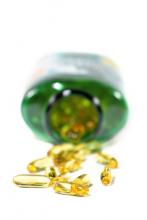NEW YORK – The vast majority of children and adults should receive a routine, daily vitamin D supplement, and this recommendation applies from age 1 year all the way up to age 70 years, Dr. Henry W. Lim said at the American Academy of Dermatology's Summer Academy meeting.
The only exception is a select group of people at high risk for vitamin D inadequacy who warrant initial testing to be sure they don’t need an even higher starting dosage of the vitamin, said Dr. Lim, professor and chairman of dermatology at Henry Ford Hospital in Detroit.
Dr. Lim based his recommendations on the revised dietary reference intakes for vitamin D issued by the Institute of Medicine last November, which set a recommended dietary allowance (RDA) of 600 IU/day for ages 1-70 years.
"In my opinion, testing [of serum vitamin D level] should only be done for people at high risk for vitamin D inadequacy," he said. In the group to consider for testing are breastfed infants, older adults with reduced skin synthesis of vitamin D, or people with limited sun exposure, dark skin, fat malabsorption (because vitamin D is fat soluble), or obesity.
"For the average individual [not in a high-risk group] my suggestion is to take 600 IU per day starting at age 1," Dr. Lim said in an interview. At that level, the supplement is relatively innocuous, inexpensive, and addresses the widespread vitamin D inadequacy. He did not rule out routine vitamin D supplements for children younger than 1 year, but noted that the RDA is lower.
Testing a person's vitamin D level costs about $100, using ICD-9 code 268.9 for unspecified vitamin D deficiency. Doing that for everyone would incur a "tremendous" cost, he said. He also echoed the recent position taken by the American Academy of Dermatology that most vitamin D should come from diet and supplements, and not from sun exposure. "It is inappropriate to recommend intentional exposure to natural or artificial UV [light] for achieving an adequate vitamin D level," he said.
People at high risk for a low vitamin D level need testing to check whether their level falls as low as 10 ng/mL or even 5 ng/mL. With this degree of deficiency, the person might need a single 10,000-IU or even 20,000-IU dose to raise their level quickly. Daily supplements should not exceed 1,000-3,000 IU in children aged 8 years or younger and should not exceed 4,000 IU daily for those aged 9-70 years, Dr. Lim said.
Two types of vitamin D are available in supplement form, D2 and D3 (ergocalciferol and cholecalciferol, respectively). The vitamin D3 form is preferable because it is more effective at raising serum levels, it attaches better to vitamin D–binding protein, and it has a longer shelf life, Dr. Lim said.
He also reviewed the evidence documenting benefit from adequate vitamin D levels. He concurred with the IOM that the best evidence by far to support maintaining a minimum serum vitamin D level involves the vitamin's effect on skeletal health. For other outcomes, the evidence is "inconsistent, inconclusive, and insufficient to inform nutritional requirements," Dr. Lim said.
Dr. Lim said that he has been a consultant to La Roche-Posay L'Oreal, Clinuvel, and Procter & Gamble and has been an investigator for Clinuvel.



